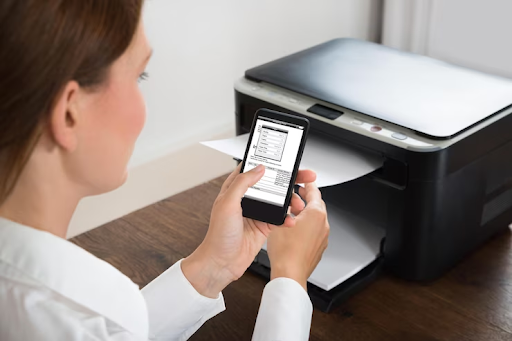In the latest speedy-paced virtual international, in which convenience and efficiency reign perfect, the area of the printing era is evolving swiftly.
With the proliferation of smartphones and capsules, the demand for cell printing answers has surged.
As a result, the destiny of printing lies in revolutionary mobile printing technology that caters to the desires of current agencies and individuals alike.
Challenges in Traditional Printing
Traditional printing methods frequently require customers to be a bodily gift at a printer linked to a laptop.
This can be inconvenient and inefficient, especially in the modern mobile-driven world in which work and communique often take location on the cross.
Additionally, conventional printing setups won’t constantly be well matched with the wide range of gadgets and operating systems in use these days.
The Rise of Mobile Printing Solutions
To address those demanding situations, a lot of mobile printing solutions have emerged in recent years. These answers leverage wireless technologies inclusive of Wi-Fi, Bluetooth, and NFC to permit seamless printing from cellular devices.
Key Features of Mobile Printing Solutions
Wireless Connectivity: Mobile printing solutions allow customers to connect to printers wirelessly, putting off the need for bodily cables and allowing printing from anywhere within range of the printer’s network.
Compatibility: Leading cell printing solutions are designed to be well matched with a huge range of gadgets and running structures, ensuring that customers can print from their desired cell platform.
Cloud Integration: Many cell printing solutions provide integration with cloud storage services which include Google Drive, Dropbox, and Microsoft OneDrive. This permits users to get right of entry to and print files stored in the cloud at once from their cellular devices.
Security: Security is a pinnacle precedence for cell printing solutions, with capabilities such as consumer authentication, encryption, and secure printing ensuring that sensitive documents stay covered.
Remote Management: Advanced cell printing solutions frequently consist of far flung control competencies, permitting directors to display and control printer settings, user permissions, and print jobs from everywhere with an internet connection.
Applications of Mobile Printing
Businesses: Mobile printing allows employees to print documents directly from their smartphones or tablets, increasing productivity and flexibility in the workplace.
Education: Mobile printing solutions are precious gear for college students and educators, permitting them to print assignments, worksheets, and coaching substances from their cell devices.
Healthcare: In healthcare settings, cell printing solutions streamline administrative tasks consisting of printing patient bureaucracy, prescriptions, and medical statistics.
Retail: Mobile printing solutions are utilized in retail environments for printing receipts, invoices, and delivery labels without delay from cell factor-of-sale (POS) systems.
The Future of Mobile Printing
Looking beforehand, the future of printing will continue to be formed by way of advancements in cell technology and connectivity. Key tendencies to look at inside the coming years consist of:
Integration with IoT: As the Internet of Things (IoT) keeps extending, we can expect to see extra integration among mobile printing answers and IoT devices, enabling automatic printing primarily based on sensor facts and different inputs.
Enhanced Security: With cybersecurity threats on the upward thrust, cellular printing solutions will maintain to prioritize security capabilities to protect touchy files and facts.
Artificial Intelligence: Artificial intelligence (AI) technologies consisting of system getting to know and natural language processing will play an increasing number of critical positions in optimizing print workflows and improving the person revel in.
Sustainability: As environmental issues end up extra prominent, mobile printing solutions will raise awareness on reducing paper waste and energy consumption through capabilities consisting of duplex printing and power-saving modes.
Customization and Personalization: Future cell printing answers may additionally contain capabilities that permit customers to customize and customize their printouts, which include adding watermarks, annotations, or digital signatures at once from their mobile gadgets.
Augmented Reality (AR) Integration: With the rise of augmented reality era, cellular printing answers may want to combine AR competencies to beautify revealed substances with interactive elements, which includes videos, animations, or three-D fashions.
Voice-Activated Printing: As the voice popularity era keeps on improving, we can also see the emergence of voice-activated printing answers that allow users to initiate print jobs and the usage of voice commands via digital assistants like Siri, Google Assistant, or Alexa.
Mobile App Ecosystem: Mobile printing solutions can also extend their app ecosystems to provide additional functionalities beyond printing, along with record scanning, PDF conversion, or record editing, creating a greater complete cellular productivity suite.
Multi-Functionality
Future cellular printers may additionally evolve to provide multi-capability, combining printing, scanning, copying, and even faxing capabilities into compact and portable devices that may be effortlessly carried and used at the pass.
Blockchain Integration
With the growing adoption of the blockchain era, cell printing answers should leverage blockchain for more desirable safety, traceability, and authentication of published files, ensuring their integrity and beginning.
Subscription-Based Printing Services
Instead of buying personal printers and supplies, users may additionally opt for subscription-based total printing services that provide entry to a network of printers and consumables, providing cost-effective and scalable printing solutions for corporations and people.
Environmental Impact Tracking
Mobile printing solutions may additionally encompass functions that music and document the environmental effect of print jobs, such as the amount of paper and ink used, carbon emissions generated, and trees stored via digital workflows, promoting sustainability and eco-aware printing practices.
Conclusion
In end, cellular printing answers constitute the destiny of printing generation, imparting comfort, flexibility, and efficiency in an increasingly cell international.
By embracing those progressive answers, agencies and people can live in advance of the curve and unencumbered new possibilities for productivity and collaboration.


